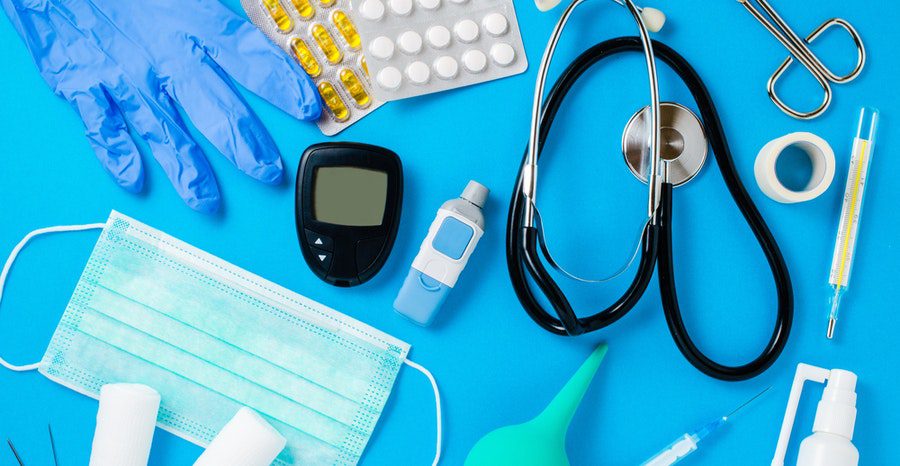
6 Common Types of Diagnostic Medical Devices
You will find extensive diagnostic medical equipment lists across hospitals, clinics and outpatient medical centres for children and adults along with emergency rooms, intensive care units, and other facilities.
Here are some common diagnostic medical devices that you will come across:
- Stethoscope- One of the most commondiagnostic equipment is the stethoscope. It is possibly one of the most popular, easily identifiable and portable diagnostic medical devices. Stethoscopes help in listening to the sounds of the lungs, heartbeats and also the blood flow within the veins and arteries. Stethoscopes are useful for the diagnosis of bronchitis, pneumonia, arrhythmia, heart ailments and palpitations, and issues with the heart valve. They are used in tandem with the sphygmomanometer for blood pressure measurements. Electronic stethoscopes enhance audio quality while hearing heartbeats and other pulmonary sounds. They may be linked to computers for recording these sounds or linked to distributors, enabling many people to listen to the same. This is vital while training fellow residents, and interns as well.
- Sphygmomanometers– Blood pressure measurements are crucial for assessing overall health and vitality of any individual. Sphygmomanometers help in diagnosis of low/high blood pressure, diabetes, arterial plaque, hardening of the arteries, hypotension and more. High blood pressure is the reason behind multiple ailments and sphygmomanometers are indispensable for measuring the same. Manual blood pressure monitoring devices are usually taken as reliable in this regard and mercury manometers do not need calibration routinely and are used for risky situations. Aneroid sphygmomanometers are slightly lower on the reliability index since they may lose calibration in case of any bump. Wall-mounted versions lower this risk although one should still check the calibration levels periodically. The aneroid style is identifiable as a mechanical unit with a dial, air valve, and bulb. Digital finger blood pressure monitors are the most portable version of this device. However, their accuracy is on the lower side. Digital sphygmomanometers are also available and may be automatically or manually inflated. They are convenient to use although indirect methods are used for blood pressure readings. Digital units track arterial pressure and this works out to an average of the diastolic and systolic pressure.
- Ophthalmoscope– Ophthalmoscopes are handheld diagnostic devices which help physicians examine the eyes of patients. They help in the diagnosis of detached retinas, bacterial infections, glaucoma etc.. Direct ophthalmoscopes produce images of roughly 15 times magnification which are upright and they are held closer to the eyes of patients. Indirect ophthalmoscopes produce images that are inverted and are two-five times magnified. They are held roughly 24-30 inches away from the eyes of patients. They also have a stronger light which is helpful in some scenarios.
- Otoscopes– Otoscopes are handheld diagnostic tools which help physicians examine the ear canal of patients while also viewing the tympanic membrane with the magnification lens. They help in the diagnosis of tinnitus, ear infections, Meniere’s disease, dizziness/vertigo, and swimmer’s ear. The head of the device comes with its own light and this, with the magnifying lens, makes it easy to view the middle and outer ear. The part inserted into the ear canal is known as disposable speculum. Specula are kept within an examination room dispenser in order to ensure the attachment of a new and cleaner one to the Otoscopes for all patients.
- Electrocardiograph– These devices track the heart’s electrical activity and the heart rate is recorded during this test. It also measures the regularity of heart beats. These are two vital indicators for understanding any heart ailments. Doctors can readily analyse electrocardiographs for working out the position and size of every heart chamber. The electrocardiograph also helps in diagnosis of any heart damage and the overall effectiveness/impact of device implants or drug treatments.
- Thermometer– This is the basic diagnostic device at hand. Thermometers are used for all types of medical and patient care, including in emergency departments, inpatient care, and routine examinations. They are now electronic in nature, lowering the required time for measurement of body temperature. Electronic thermometers may be used for specific body parts that are being measured, like right under the armpit, mouth, ear or rectally.
You can easily shop for these medical diagnostic devices anywehre in Australia, from our online disability aids provider.





Kubetvip8 é a melhor! Jogos incríveis, pagamentos em dia e um suporte que realmente te ajuda. Não troco por nada kubetvip8.
188bet’s always been a solid choice. Nhacai188bet just makes it easier to access. Good odds and a wide range of sports. Give it a shot if you’re feeling lucky! Link’s right here: nhacai188bet